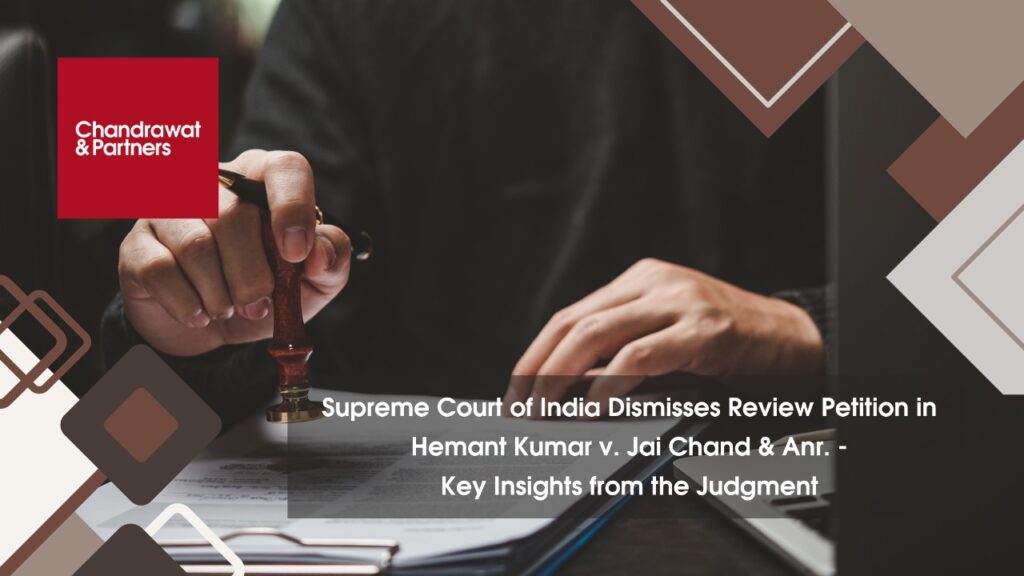Home > Recent Judgements > Supreme Court of India Dismisses Review Petition in Hemant Kumar v. Jai Chand & Anr. – Key Insights from the Judgment
Mar 20, 2025
Supreme Court of India Dismisses Review Petition in Hemant Kumar v. Jai Chand & Anr. – Key Insights from the Judgment
On March 18, 2025, the Supreme Court of India delivered a significant judgment in the matter of Hemant Kumar v. Jai Chand & Anr. The Court dismissed a review petition that sought to challenge its earlier order. The bench, consisting of Justices Vikram Nath and Prasanna B. Varale, found that there was no error apparent on the face of the previous judgment, thereby upholding the original ruling.
This blog delves into the details of the case, the grounds of the review petition, the Court’s reasoning behind dismissing the petition, and its broader implications on legal procedures in India.
Case Background: Hemant Kumar v. Jai Chand & Anr.
The case revolved around a dispute between Hemant Kumar and Jai Chand, along with another party, over an earlier decision issued by the Supreme Court. The matter had been previously adjudicated by the Court, and the petitioners had been dissatisfied with the judgment, prompting them to file a review petition.
Review petitions are a mechanism in the Indian judicial system where a party seeks to challenge a judgment passed by a higher court, asserting that there has been a glaring error or an oversight in the earlier ruling. In this case, Hemant Kumar sought to have the Supreme Court’s earlier order reconsidered.
The Review Petition
Hemant Kumar, represented by his legal team, argued that there was an apparent error in the judgment passed in the case of Hemant Kumar v. Jai Chand & Anr. The petitioners contended that the previous judgment failed to consider certain facts or legal provisions that were pivotal to the case. They requested the Court to examine the matter afresh, citing these alleged oversights as grounds for a review.
Supreme Court’s Dismissal of the Review Petition
The bench, comprising Justices Vikram Nath and Prasanna B. Varale, carefully examined the review petition. After a detailed review, the Court concluded that there was no apparent error or glaring mistake in the earlier judgment that warranted a re-evaluation of the decision. The bench emphasized that a review petition is not meant to be an appeal or a re-hearing of the case; it is intended only for situations where there is an error apparent on the face of the record.
In this instance, the Court found that the petitioners had not demonstrated any such error. As a result, the review petition was dismissed, and the earlier judgment was upheld.
Understanding the Review Process in India
The review process in India is governed by the provisions of Order 47 of the Civil Procedure Code (CPC). According to this provision, a party may file a review petition before the same court that delivered the judgment if they believe there has been an error apparent on the record. However, review petitions are not meant to re-argue the case or present new evidence.
The grounds for review are typically limited to:
- Mistakes Apparent on the Face of the Record – This refers to errors in the judgment that are self-evident, without the need for further investigation or analysis.
- New Evidence – If the petitioning party can present new evidence that was not available at the time of the original ruling and could have materially affected the outcome, a review petition may be considered.
- Manifest Injustice – If a judgment has resulted in an obvious miscarriage of justice, a review petition may be allowed.
In the Hemant Kumar v. Jai Chand & Anr. case, the Supreme Court found no such grounds and therefore rejected the petition.
The Role of the Supreme Court in Review Petitions
The dismissal of review petitions is an essential aspect of maintaining the finality of judgments. If every unfavorable judgment could be contested multiple times, it would lead to a perpetual cycle of litigation, delaying justice and clogging the court system.
While the Supreme Court is open to reviewing its judgments in cases where there is an undeniable error, the Court is careful not to allow frivolous or repetitive petitions that merely challenge its findings. This ensures that review petitions are used judiciously and only in exceptional circumstances.
Implications of the Judgment
- Reaffirming the Finality of Supreme Court Decisions: By dismissing the review petition, the Supreme Court reinforced the idea that its judgments are final unless there is a clear and tangible error that warrants reconsideration.
- Judicial Discipline: The judgment highlights the importance of judicial discipline and the need to respect the finality of decisions in the legal process. The dismissal discourages the filing of frivolous review petitions that seek to re-litigate matters without a valid legal basis.
- Clarification of Review Petition Standards: This decision provides clarity on the standards for filing review petitions. The Court emphasized that review petitions are not meant to be a second chance to present arguments or evidence but must be based on clear and evident mistakes in the original ruling.
Conclusion
The Supreme Court’s decision to dismiss the review petition in the Hemant Kumar v. Jai Chand & Anr. case serves as an important reminder of the limitations and purpose of review petitions in India’s judicial system. The Court upheld the finality of its earlier judgment, emphasizing that review petitions must be based on clear and obvious errors in the record.
This judgment not only upholds the principles of judicial discipline but also strengthens the credibility of the judicial process in India, ensuring that the focus remains on delivering timely and fair justice. As the legal landscape evolves, the Court’s role in maintaining the integrity and finality of its decisions remains crucial in ensuring justice is served efficiently.
For more information or queries, please email us at
[email protected]





